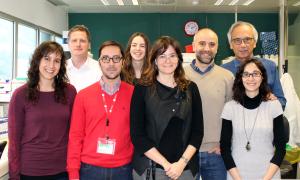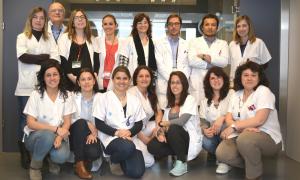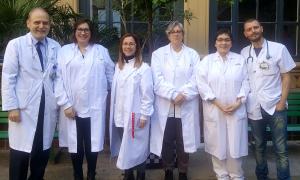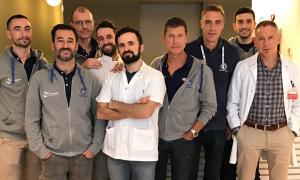A therapeutic HIV vaccine clinical trial induces viral control in 5 people without taking antiretroviral therapy
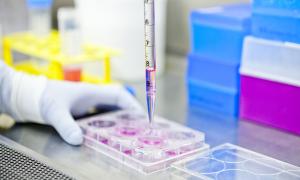
A clinical trial conducted by the IrsiCaixa AIDS Research Institute and the Fight AIDS Foundation has induced HIV control in 5 people who have been in an antiretroviral pause for 5, 13, 17, 20 and 27 weeks, respectively. Usually virus rebounds during the first 4 weeks after treatment interruption. This is the first therapeutic intervention against HIV that has proved to be successful in reeducating the immune system of HIV-infected people, enabling it to keep the virus under control while not taking antiretroviral drugs.
A therapeutic HIV vaccine clinical trial showed, for the first time, that in some cases the immune system of HIV infected people can be reeducated to control the virus for long periods without taking antiretroviral treatment. In particular, 5 out of 13 participants who stopped treatment (38.5%) have been controlling the virus for 5, 13, 17, 20 and 27 weeks, respectively. The study, still ongoing, is conducted in Barcelona and tests a vaccine developed by researchers at Oxford University in combination with a drug, romidepsin, able to awaken latent viruses in the body. The study is conducted by IrsiCaixa and the Fight AIDS Foundation and performed at the Germans Trias i Pujol University Hospital (Barcelona), the Hospital Clínic-IDIBAPS de Barcelona and the community center BCN Checkpoint.
Funding comes from the Fundació Glòria Soler, the Gala Sida Barcelona and the Instituto de Salud Carlos III of the Spanish Ministry of Economy, Industry and Competitiveness. The HIVACAT program, supported by “la Caixa Foundation”, the Catalan Government and the Fundació Clínic, also contributes to the trial. Preliminary results have been presented at the 2017 Conference on Retroviruses and Opportunistic Infections (CROI), the world’s largest conference on HIV/AIDS, in Seattle.
Usually, plasma viral load rebounds during the first 4 weeks after the interruption of treatment. In 5 patients that have not needed to restart therapy, there were occasional small magnitude rises in viral load after antiretroviral treatment (ART) interruption, but they decreased within a short time. "It looks like we managed to both weaken the virus and strengthen the immune system of patients, enabling it to react effectively against the virus’ attempts to rebound", explains Dr. Beatriz Mothe, MD-PhD, associate researcher at IrsiCaixa and coordinator of the trial.
This is a similar behavior as the one observed in the so-called “viral controllers”, whose immune system is able to control plasma viral load without drugs. "It is the first time that such a substantial number of trial participants become viral controllers after a therapeutic intervention, either a vaccine or other immunotherapy", adds Dr. Mothe. "This is a very important step because it shows that therapeutic vaccination for HIV is possible. Now we aim at understanding how to improve the effectiveness of this strategy further, whether with a better vaccine, repeated cycles of lower doses of latency-reversing agents or the use of other products that are under development. There are still many questions to answer”, says Dr. José Moltó, MD, co-principal investigator from the Fight AIDS Foundation. Previous studies, conducted by other centers to test different vaccines and drugs in people with chronic infection, did not achieve similar results.
Aiming at ‘awakening’ the latent virus and destroying infected cells
HIV-infected cells that remain latently infected in the body represent the viral reservoir. These infected cells cannot be detected by the immune system. The reservoir is the reason why treatment cannot be interrupted, and the only way to destroy it is awakening it to detect the hiding places and destroy all infected cells with an effective immune response (“kick & kill strategy”).
This was the aim of this proof-of-concept study, so-called BCN 02-Romi. BCN 02 trial was initiated as a roll-over study in patients that had participated in the BCN 01 trial, developed under the HIVACAT program and with the support of Fundació Glòria Soler. BCN 01 trial included individuals who started treatment during the first six months after HIV infection (“early treatment'') and received ChAdV63.HIVconsv and MVA.HIVconsv vaccines, designed by Oxford University and focused on conserved parts shared among HIV variants. After demonstrating an induction of strong immune response to vaccinations, all patients were maintained under effective ART until BCN 02 trial was initiated. Here, 15 patients were given a booster MVA.HIVconsv vaccine followed by three doses of Romidepsin (provided by Celgene). Romidepsin is a chemotherapy drug for hematological diseases, and was added to the regimen because earlier studies had shown that it can reverse the HIV latency.
Participants who showed a positive immune response to the vaccine were invited to undergo an antiretroviral pause with weekly monitoring. To date, there are 5 potential “viral controllers”, 8 individuals who had to restart treatment after rebounding virus was detected very early, one more will interrupt treatment shortly and another one did not mount satisfactory immune responses after vaccination.
Cohort of early detected and early treated people
The participants in the trial come from a cohort of early-treated individuals, who started taking antiretroviral therapy during the 6 first months after HIV infection. These results confirm the importance of early detection of HIV infection and suggest that treatment initiation during the first weeks after HIV infection may contribute to the limitation of the reservoir size and maintenance of a strong and functional immune response, potentially leading to a better response to vaccination. The community-based center for the detection of HIV and other STIs BCN Checkpoint has collaborated on the establishment of this cohort over the last 3 years. It is also involved in the trial through the weekly monitoring of patients during the antiretroviral pause, using cutting-edge technology to detect any viral rebound in less than 90 minutes.
